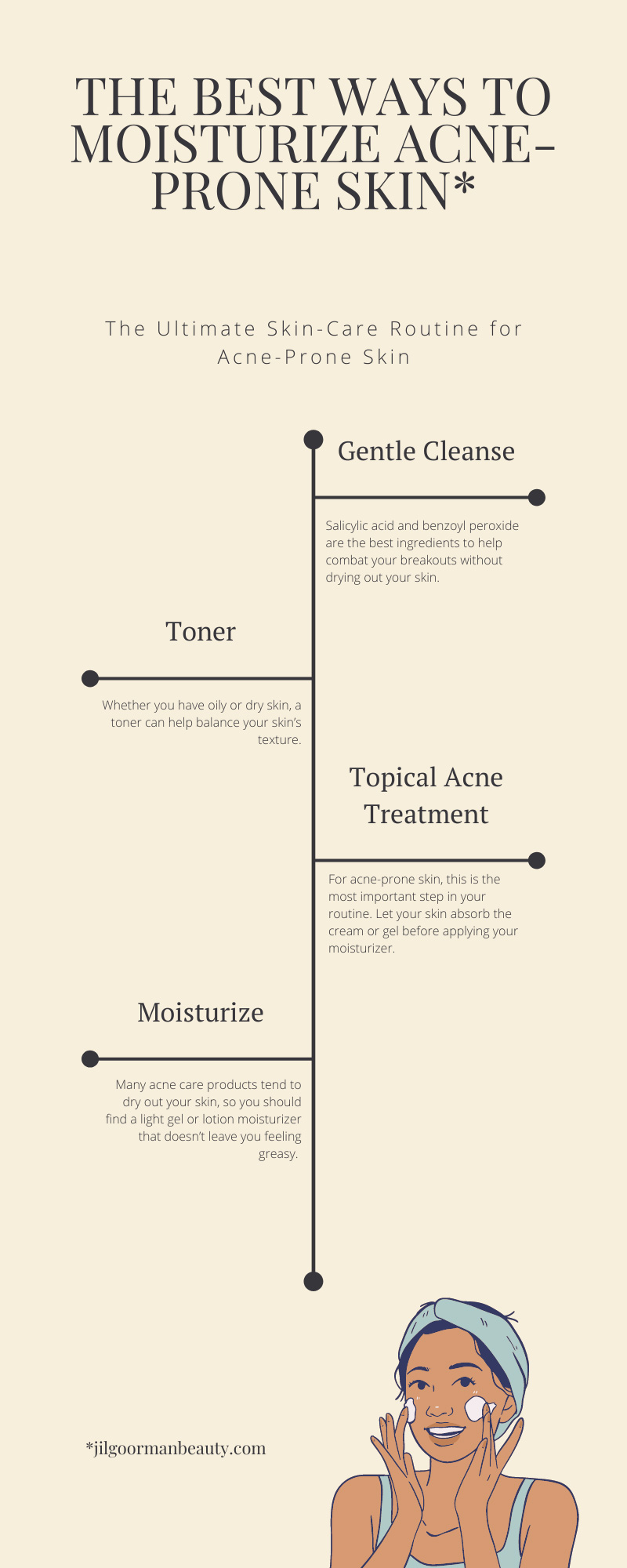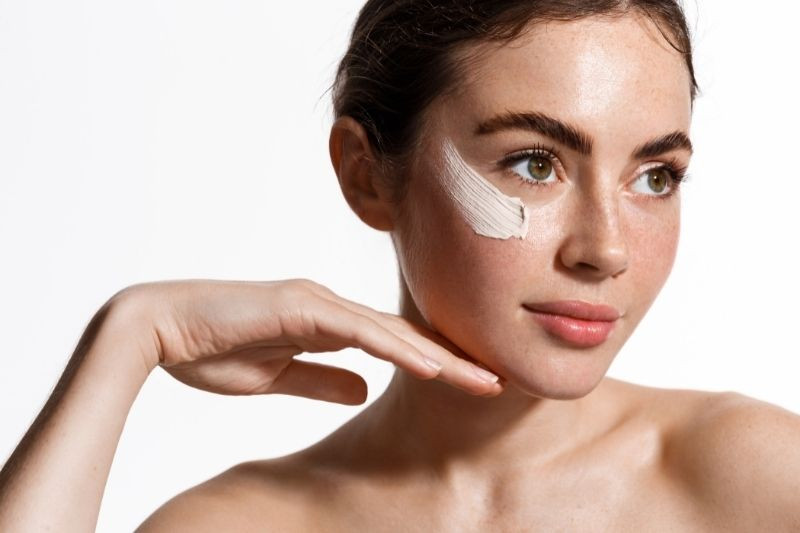No matter your skin type, moisturizing should be a primary pillar of your skin-care routine. While some products can clog your pores and worsen your acne, it’s crucial to find a good moisturizer that’s right for you. Even though there are many factors to consider when it comes to cultivating the best daily skin-care regimen, you should never skip moisturizing. Delve into the best ways to moisturize acne-prone skin.
The Ultimate Skin-Care Routine for Acne-Prone Skin
While you might think you need an extensive regimen to combat your acne, these four easy steps twice a day are all you need to keep your skin clear and vibrant.
Gentle Cleanse
The way that you cleanse is equally as important as the product you use. Be sure to get a cleanser that’s right for your skin type. Salicylic acid and benzoyl peroxide are the best ingredients to help combat your breakouts without drying out your skin.
Use your fingertips or a soft washcloth to rub the cleanser into your skin. Be sure to cover your face, jawline, neck, and even behind your ears for the best clean. While you might feel the urge to scrub your skin, it will worsen the irritation rather than clean it better.
Additionally, you should consider cleaning your face twice at night if you wear makeup or sweat heavily during the day. The additional cleanse and rinse ensures you remove any excess dirt, oil, and makeup every night before it has a chance to wreak havoc on your skin.
Toner
Although many people don’t see the value in using a toner or astringent, it can help your acne-prone skin in more ways than one. Whether you have oily or dry skin, a toner can help balance your skin’s texture. They work to remove excess dirt, oil, and makeup while hydrating and rejuvenating your skin and fighting blemishes and breakouts.
Using a toner is incredibly easy: apply it to a cotton ball or pad and gently rub it into your entire face and neck. Let it air dry before moving on to the next step in your routine.
Pro-Tip
The best toners contain glycerin and rosehip oil and are alcohol-free!
Topical Acne Treatment
After your face is completely dry, gently apply your acne treatment cream or gel. For acne-prone skin, this is the most important step in your routine. Let your skin absorb the cream or gel before applying your moisturizer.
Moisturize
Even if your skin always seems oily, you shouldn’t take that as a sign that you don’t need hydration. Many acne care products tend to dry out your skin, so you should find a light gel or lotion moisturizer that doesn’t leave you feeling greasy. On the other hand, a cream moisturizer is an excellent option for you if you have dry skin.
You can purchase a complete acne kit for dry skin, oily skin, and even combination skin to avoid the hassle of handpicking the best products for your skin-care routine. It’s the best way to guarantee that the products will work together for the best results.
Choosing the Best Moisturizer for You
Finding a good moisturizer for acne-prone skin is more complicated than finding one for average skin. Nevertheless, there’s one out there that’s right for you. Follow these guidelines to ensure you’re not wasting your time and money on a product.
Oil-Free
Since acne-prone skin usually means excessively oily skin, you don’t need to add extra oil to the mix. Your skin still needs moisture, but you should find an oil-free product. Try looking for water- or glycerin-based products for oily skin, and avoid any oil ingredients, such as coconut oil.
There are moisturizers for acne-prone skin that contain salicylic acid and benzoyl peroxide to keep your breakouts in check while keeping your skin hydrated and balanced.
Non-Acnegenic
Non-acnegenic moisturizers are a must-have for acne-prone skin. They are always oil-free and won’t cause breakouts, blackheads, or irritate your skin. You can find non-acnegenic products relatively easily, and they’re inexpensive.
Jojoba Oil
Although you should avoid oils at all costs, jojoba oil isn’t technically an oil. It’s a form of wax that comes from jojoba seeds. It works by mimicking sebum, and it tricks your skin into thinking it has already produced enough sebum. As a result, your skin produces less oil, reducing your risk for breakouts.
While the effects of jojoba oil are just a theory as of right now, many people swear by it. Unfortunately, it’s relatively expensive to try, but it might be worth the money if it works for you.
SPF
Because your face is the most exposed part of your body, you need an SPF product to protect your skin from dangerous UV rays and potential skin cancer. Many people use a separate sunscreen product in their skin-care routine; however, you can buy moisturizers that contain SPF, making it a 2-in-1 product.
Regardless of your skin type, you should always wear some form of SPF on your face, whether it’s sunny or not. If you plan to spend an extended period in the sun, your moisturizer won’t cut it. You’ll need additional sunblock to reapply to your skin throughout the day.
Treat Instead of Covering
When you have acne and blemishes, it’s tempting to keep your breakouts covered with makeup constantly. However, you might do more harm than good by covering it up. Consider giving your skin some time to breathe by taking a few days off from applying heavy makeup.
Covering your face is exhausting. Treat your breakouts properly right off the bat to ensure your skin gets back to being vibrant as soon as possible. Your acne is more likely to heal faster if you don’t clog your pores with concealer and foundation. Additionally, you’ll be confident in your natural skin if you treat your acne instead of covering it up.
After learning the best ways to moisturize acne-prone skin, you should be on the right road to the most beautiful and vibrant skin you’ve ever seen. Skin care isn’t nearly as complicated as it may seem, so do yourself a favor and create a routine that works for your skin.


